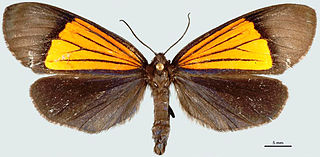
Notodontidae is a family of moths with approximately 3,800 known species. The family was described by James Francis Stephens in 1829. Moths of this family are found in all parts of the world, but they are most concentrated in tropical areas, especially in the New World.

Dioptinae is a subfamily of the moth family Notodontidae.

Notascea is a genus of moths of the family Notodontidae. It consists of the following species:

Scea subcyanea is a moth of the family Notodontidae. It is found in Peru.
Oricia is a genus of moths of the family Notodontidae. It was described in 1854 by English entomologist Francis Walker and contains four species distributed in Central and South America.
Eremonidia is a monotypic moth genus of the family Notodontidae. Its only species, Eremonidia mirifica, is known from two mountain ranges in the south-western part of the Dominican Republic. Both the genus and species were first described by John E. Rawlins and James S. Miller in 2008.

Disphragis is a genus of moths of the family Notodontidae erected by Jacob Hübner in 1820. The genus is confined to the New World and it contains about 137 species.
Erbessa lamasi is a moth of the family Notodontidae first described by James S. Miller in 2008. It is found in south-eastern Peru.
Erbessa stroudi is a moth of the family Notodontidae first described by James S. Miller in 2008. It is found on the slopes of the Cordillera Central in northern Costa Rica.
Erbessa thiaucourti is a moth of the family Notodontidae first described by James S. Miller in 2008. It is found in French Guiana.
Xenorma australis is a moth of the family Notodontidae. It is found in Brazil.
Phaeochlaena costaricensis is a moth of the family Notodontidae first described by James S. Miller in 2008. It is found in Costa Rica and Panama.
Phaeochlaena gyon is a moth of the family Notodontidae first described by Johan Christian Fabricius in 1787. It is endemic to the Guyana Shield and points west, at least as far as the Upper Amazon basin of Colombia and Ecuador.
Polypoetes wagneri is a moth of the family Notodontidae first described by James S. Miller in 2008. It is found in Costa Rica.
Hadesina goeleti is a moth of the family Notodontidae first described by James S. Miller in 2008. It is found in north-western Costa Rica, near the Nicaraguan border.
Nebulosa huacamayensis is a moth of the family Notodontidae first described by James S. Miller in 2008. It is found in cloud-forest habitats in Ecuador.
Nebulosa hermani is a moth of the family Notodontidae first described by James S. Miller in 2008. It is restricted to the western side of the Ecuadorian Andes.
Euchontha moyobamba is a moth of the family Notodontidae first described by James S. Miller in 1989. It is found in Peru.

Dunama is a genus of moths of the family Notodontidae described by William Schaus in 1912.
Luca yanayacensis is a moth of the family Notodontidae first described by James S. Miller in 2011. It is found in north-eastern Ecuador.





